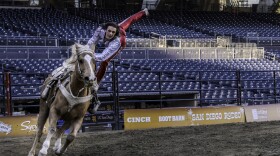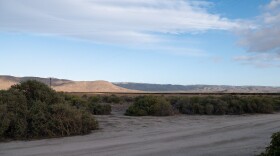When Maria Theresa Fernandez gazed at the barrier separating San Diego and Tijuana — she saw more than a wall. Through her lens, it was a living, breathing creature.
Over 25 years of photographing the wall, Fernandez witnessed two major transformations. The first being a period of rapid militarization that added a barrier and a massive increase in surveillance.
The second was a metamorphosis on the Tijuana side. Politicians covered the wall with campaign slogans during election season. Local churches used it as a public bulletin board for community events. And artists used it as a canvas to illustrate the plight of migrants.
“Since I started, I had this feeling that this object, this wall, was alive,” Fernandez said. “I saw, during all this time, that it was changing. It was growing in length and height. It was reproducing.”
Then, in 2023, the Biden administration began tearing down the wall to build a taller one. All of a sudden, this living being was dying. Fernandez saw the art being destroyed, and along with it an important slice of history.
“Those posts have so many fingerprints of people that were holding them anxiously and very tightly waiting for their loved ones to arrive,” Fernandez said. “Those little things may be difficult to see, but they mean a lot to the history of this area.”

Many others feel the same way as Fernandez. Among them are the border advocacy group Friends of Friendship Park and other local stakeholders who are leading an effort to save as many sections of the old border wall as possible.
“We knew that the community on the Mexico side had invested so much love and care and energy and creativity on that side that we wanted to make sure that some of that was preserved,” said John Fanestil of Friends of Friendship Park.
'They don't belong to us'
To aid them in their quest, the group asked Balboa Park’s Museum of Us for help. Micah Parzen, CEO of the Museum of Us, remembers Fanestil’s phone call.
“He said, ‘Would you consider having the museum try to obtain these sections of the wall before they get destroyed,’” Parzen said. “And we absolutely jumped at the opportunity.”
With funding from the Conrad Prebys Foundation, the Museum of Us acquired 20 sections of the wall.
Parzen described it as a long and complicated bureaucratic process. It involved multiple phone calls with Customs and Border Protection (CBP) and conversations with the private contractor chosen to replace the border wall. Each section is 8 feet wide and weighs 4,300 pounds, which create logistical challenges.
The museum used a flatbed truck to move a few pieces at a time, and partnered with a facility in the South Bay to store them. They will be stored in this undisclosed location until they find a new home — which won’t necessarily be in a museum, Parzen said.
“They don’t belong to us, they belong to the community,” he said. “It’s the community that should come together and decide how this wealth gets distributed to our tri-national region.”
By tri-national, Parzen meant the United States, Mexico and the Kumeyaay people. Long before the U.S. or Mexico existed, Kumeyaay lived in the region.

“We originally inhabited the area from down around Ensenada up to Capistrano,” said Brandon Linton a cultural consultant and member of the Kumeyaay Nation. “The U.S.-Mexico border, from its conception, split our homeland virtually in half”
Linton, who has worked with the Museum of Us in the past, said the border wall's separation of the Kumeyaay people has devastated generations.
“I think this project is a great way to bring attention to that,” he said.
The various stakeholders will spend the next year figuring out where and how to display these unique artifacts. They envision a community-guided process that involves setting up an advisory committee and holding public events in San Diego and Tijuana.
Fanestil said sections of the wall could eventually be installed in public spaces on either side of the border, as an exhibit in a museum or even a traveling installation.
“These are all possibilities,” he said.







